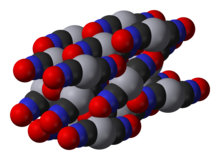Loading AI tools
Chemical compound From Wikipedia, the free encyclopedia
Mercury(II) fulminate, or Hg(CNO)2, is a primary explosive. It is highly sensitive to friction, heat and shock and is mainly used as a trigger for other explosives in percussion caps and detonators. Mercury(II) cyanate, though its chemical formula is identical, has a different atomic arrangement, making the cyanate and fulminate anions isomers.
 | |
 | |
 | |
| Names | |
|---|---|
| IUPAC name
Mercury(II) fulminate | |
| Systematic IUPAC name
Dioxycyanomercury | |
| Other names
Fulminated Mercury | |
| Identifiers | |
3D model (JSmol) |
|
| ChEBI | |
| ChemSpider | |
| ECHA InfoCard | 100.010.053 |
PubChem CID |
|
| UNII | |
CompTox Dashboard (EPA) |
|
| |
| |
| Properties | |
| C2N2O2Hg | |
| Molar mass | 284.624 g/mol |
| Appearance | Grey, Pale Brown, or White Crystalline solid |
| Density | 4.42 g/cm3 |
| Melting point | 160 °C (320 °F; 433 K) |
| Boiling point | 356.6 °C (673.9 °F; 629.8 K) |
| slightly soluble | |
| Solubility | soluble in ethanol, ammonia |
| Explosive data | |
| Shock sensitivity | High |
| Friction sensitivity | High |
| Detonation velocity | 4250 m/s |
| Hazards | |
| Occupational safety and health (OHS/OSH): | |
Main hazards |
Highly Toxic, Shock Sensitive Explosive |
| NFPA 704 (fire diamond) | |
| 170 °C (338 °F; 443 K) | |
Except where otherwise noted, data are given for materials in their standard state (at 25 °C [77 °F], 100 kPa).
| |
First used as a priming composition in small copper caps beginning in the 1820s, mercury fulminate quickly replaced flints as a means to ignite black powder charges in muzzle-loading firearms. Later, during the late 19th century and most of the 20th century, mercury fulminate became widely used in primers for self-contained rifle and pistol ammunition; it was the only practical detonator for firing projectiles until the early 20th century.[1] Mercury fulminate has the distinct advantage over potassium chlorate of being non-corrosive, but it is known to weaken with time, by decomposing into its constituent elements. The reduced mercury which results forms amalgams with cartridge brass, weakening it, as well. Today, mercury fulminate has been replaced in primers by more efficient chemical substances. These are non-corrosive, less toxic, and more stable over time; they include lead azide, lead styphnate, and tetrazene derivatives. In addition, none of these compounds requires mercury for manufacture, supplies of which can be unreliable in wartime.
Mercury(II) fulminate is prepared by dissolving mercury in nitric acid and adding ethanol to the solution. It was first prepared by Edward Charles Howard in 1800.[2][1] The crystal structure of this compound was determined only in 2007.[3]
Silver fulminate can be prepared in a similar way, but this salt is even more unstable than mercury fulminate; it can explode even under water and is impossible to accumulate in large amounts because it detonates under its own weight.[4]
The thermal decomposition of mercury(II) fulminate can begin at temperatures as low as 100 °C, though it proceeds at a much higher rate with increasing temperature.[5]
A possible reaction for the decomposition of mercury(II) fulminate yields carbon dioxide gas, nitrogen gas, and a combination of relatively stable mercury salts.
Seamless Wikipedia browsing. On steroids.
Every time you click a link to Wikipedia, Wiktionary or Wikiquote in your browser's search results, it will show the modern Wikiwand interface.
Wikiwand extension is a five stars, simple, with minimum permission required to keep your browsing private, safe and transparent.